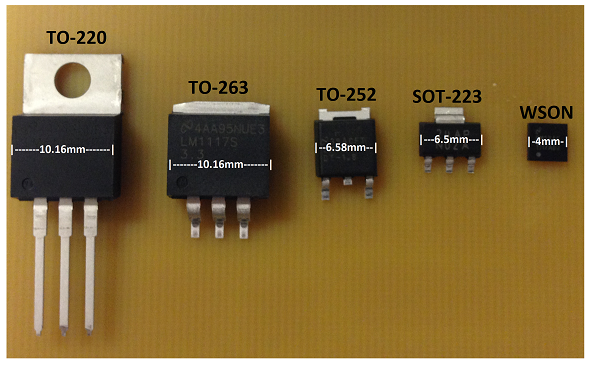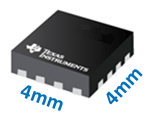SSZTC98 August 2015 LM1117 , LM317-N , LM317A
As more and more features are packed into industrial and automotive electronic systems, smaller, robust packages become even more attractive. However, to ensure that the electronic design is thermally robust, you need to have a proper understanding of the various package options. This is particularly true of linear regulators where input to output voltage differences can be large and cause immense power dissipation. There are two main types of packages: surface mount and through hole.
Through-hole package options, such as the T0-220 shown in Figure 1, have leads that are soldered into drilled holes in the PCB. Surface-mount package options, on the other hand, are soldered directly onto the PCB surface. Common surface mount packages, such as the TO-263, TO-252, SOT-223, and WSON are shown in Figure 1.
 Figure 1 Common Voltage Regulator
Packages
Figure 1 Common Voltage Regulator
PackagesThrough-hole packages, such as the TO-220, require vertical mounting (or leads bent at 90 degrees) and holes drilled through the PCB, often obstructing potential routing layers underneath. Through-hole mounting is typically used when components are mounted by hand and PCBs are single or double sided. With pick-and-place technology and multiple board layers, surface-mount packages are now more common. If you are considering only surface area, the SOT-223 and the WSON would be good choices.
Another key consideration in package choices is the thermal resistance. Two specifications are often seen in the datasheets - ThetaJc is specified as the ratio of temperature difference between package surface and junction (or back side of the integrated circuit die) to the device power consumption. ThetaJa (θJA) is specified as the ratio of difference between the ambient temperature and junction (or back side of the integrated circuit die) to the device power consumption.
Input voltages in industrial applications can range from 12-V and 24-V backplane rails to off-line supplies that can be much higher. Automotive battery voltage, while nominally 12 V and 24 V (for car and truck), can have excursions due to cold crank and load dump conditions. A wide input to output voltage range is, thus, quite common. Depending on the load current, this could cause high levels of thermal dissipation in the voltage regulators leading to the use of packages, such as TO-263 and TO-252, traditionally considered thermally more efficient. Portable and hand-held applications often run on batteries or lower input voltage supplies with mostly low currents. These applications are space-constrained and often lean towards smaller footprint packages such as WSON or SOT-223. However, with proper PCB design and/or a package with a thermal pad (which helps dissipate heat through the PCB), one can get the best of both worlds: small size and high heat dissipation capabilities.
 Figure 2 WSON Package
Figure 2 WSON PackageAs an example, TI’s LM1117-N WSON package shown in Figure 2 has θJA = 40 °C/W. This is, to some extent, due to the thermal pad which allows for better heat dissipation. The SOT-223 package, shown below in Figure 3, is considered to have poorer thermal resistance than TO-263 and TO-252 packages.
 Figure 3 SOT-223 Package
Figure 3 SOT-223 PackageHowever, taking proper precautions in PCB design can render a comparably low thermal resistance for this SOT-223 package. As explained in the section on heat sinks in the LM317A datasheet and as can be seen in Figure 4 below, the SOT-223 package can render thermal resistance comparable to the TO packages, which are more popular due to their better thermal resistance.
 Figure 4 ThetaJA vs Copper (2 Ounce)
Area for the SOT-223 Package
Figure 4 ThetaJA vs Copper (2 Ounce)
Area for the SOT-223 PackageWith proper PCB design, one can take advantage of the smaller size of the LM317A in a SOT-223 package and still get great thermal resistance.
Additional Resources
- Consider TI’s LM317A 3-terminal adjustable voltage regulator and LM1117-N 800mA low-dropout linear regulator for your next design.
- Get more information on all of TI’s linear regulators.
- Read the Power House blog, “Identify the most accurate linear voltage regulator.”
- Simulate your design using an LM1117-N SPICE model.